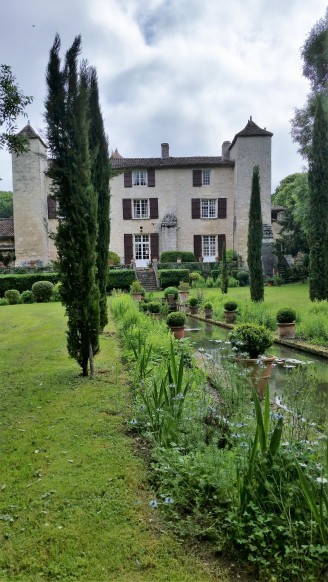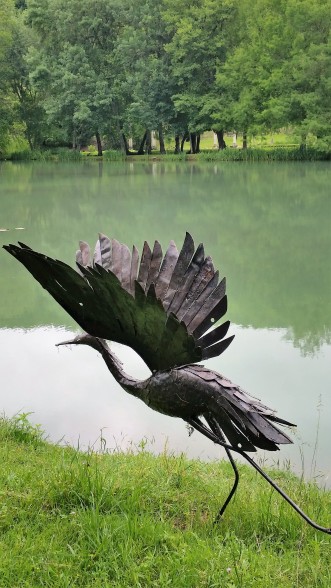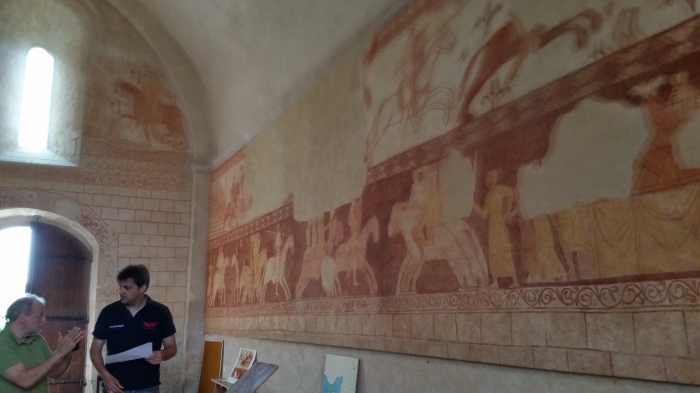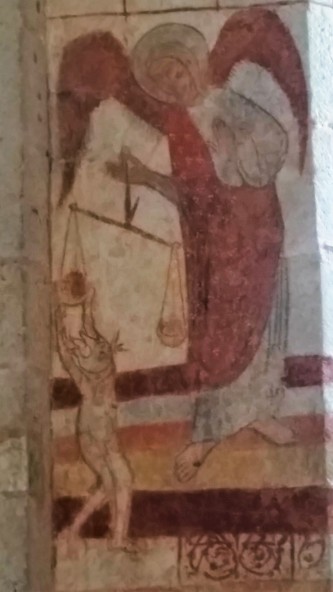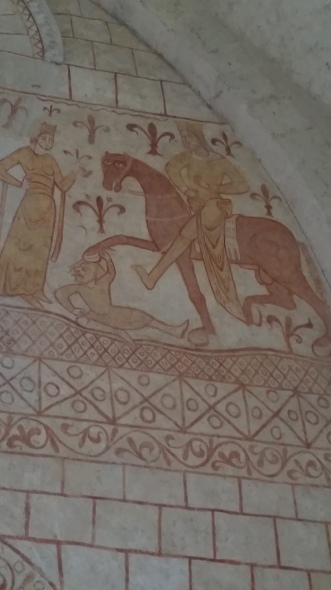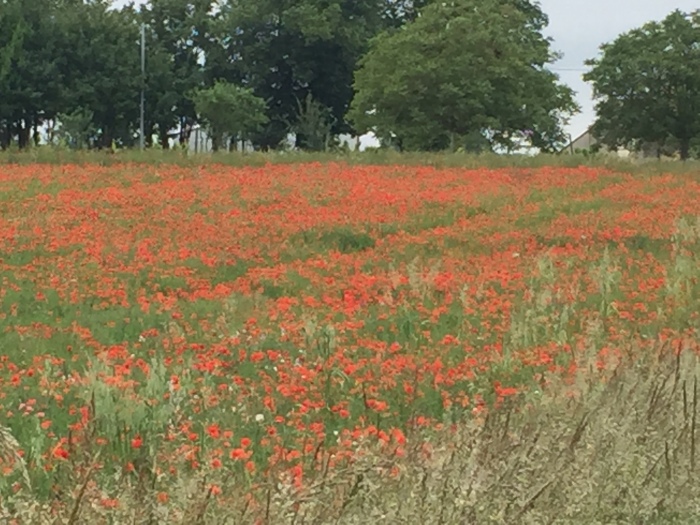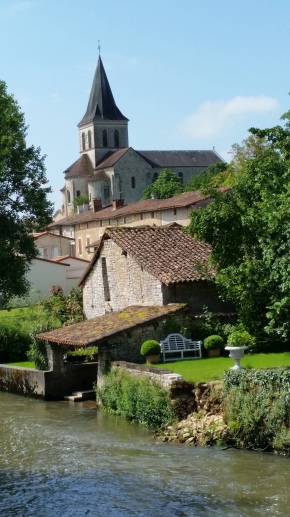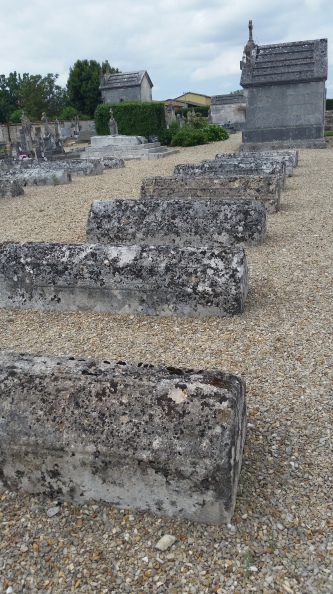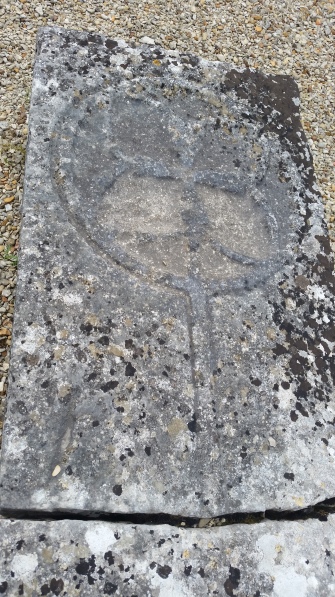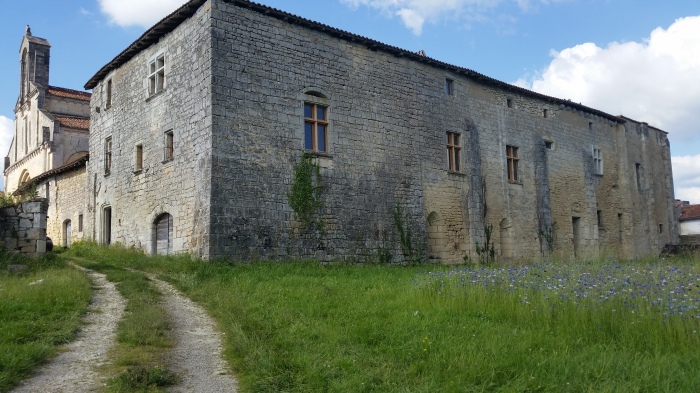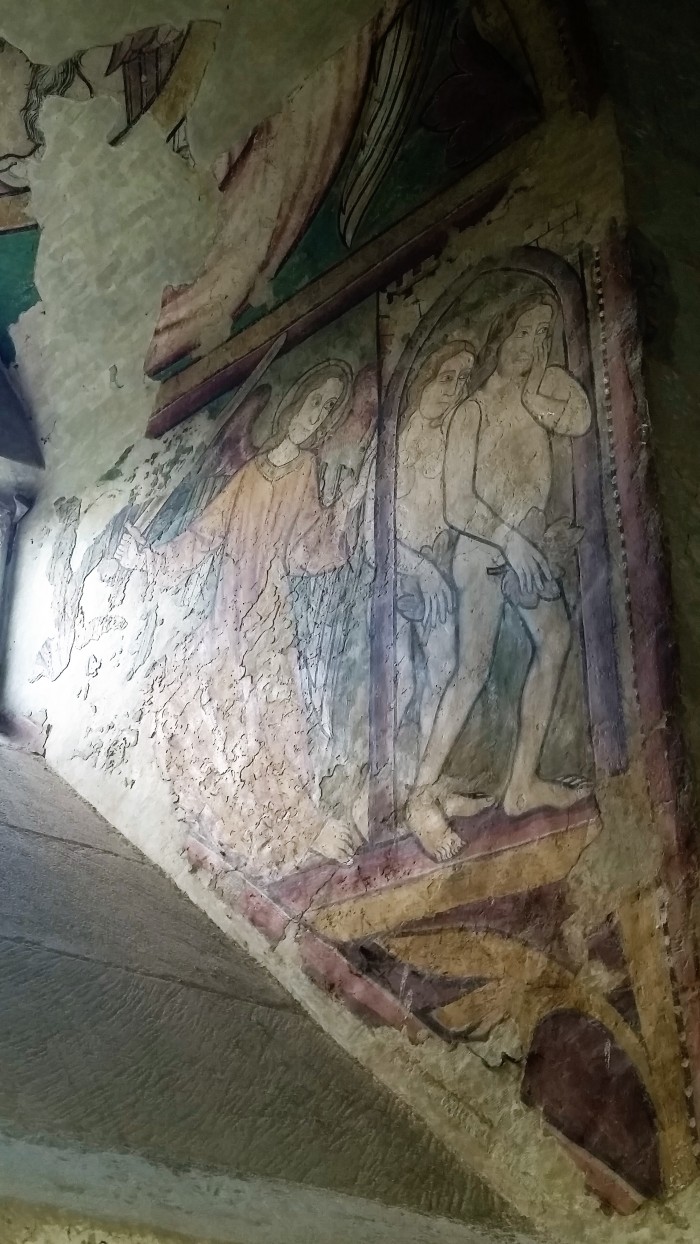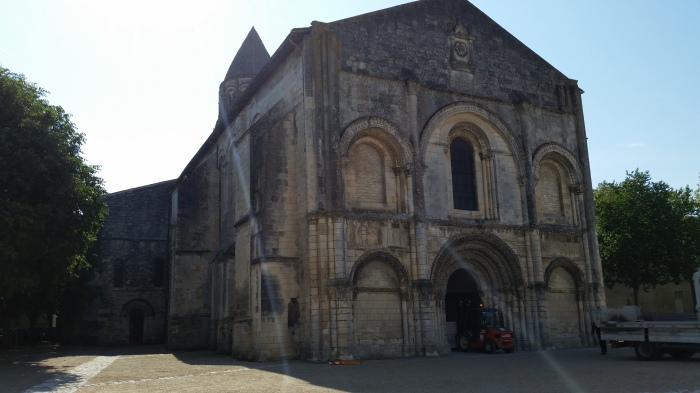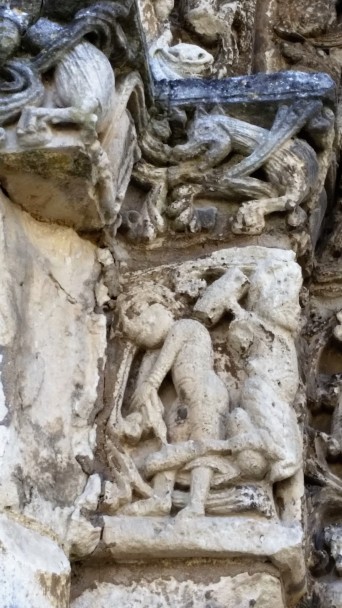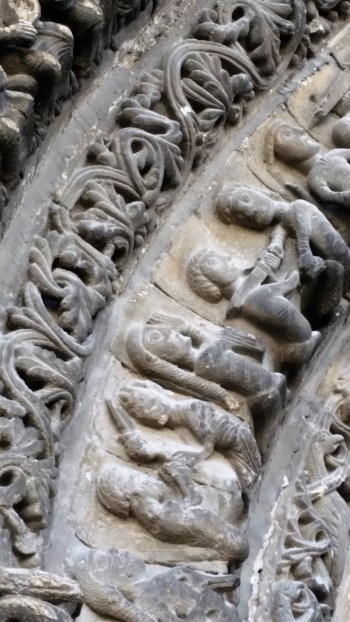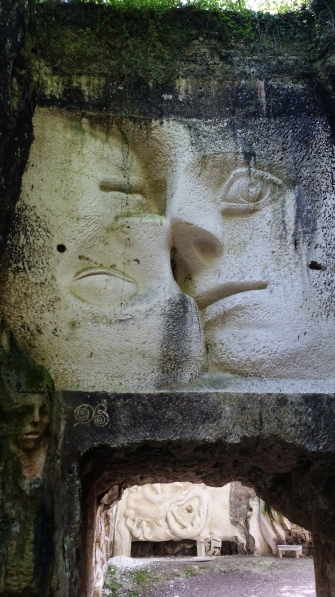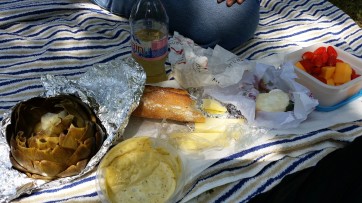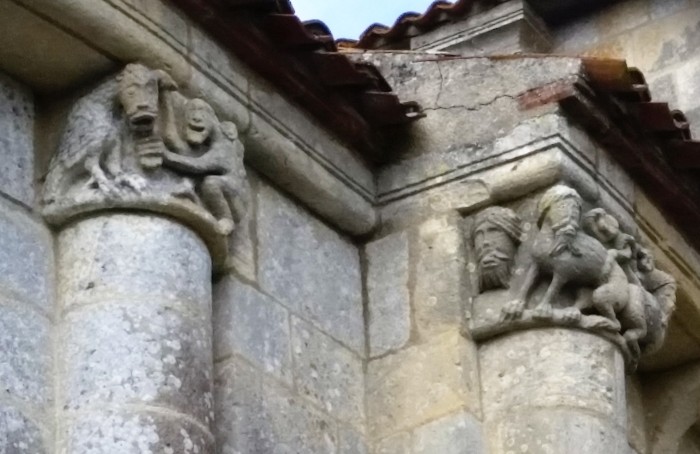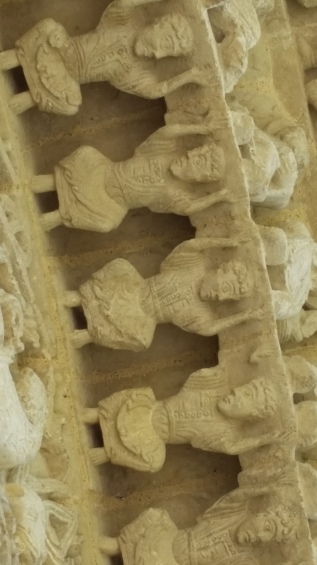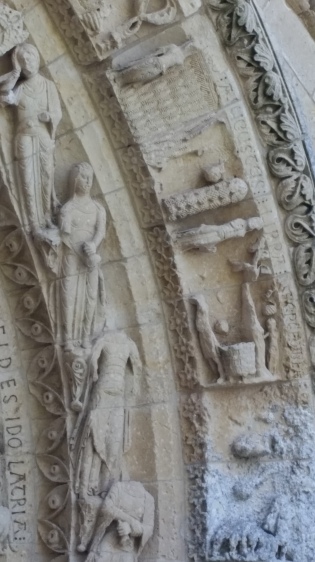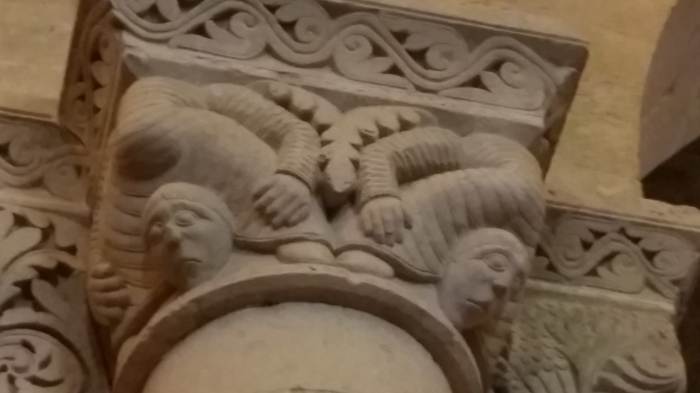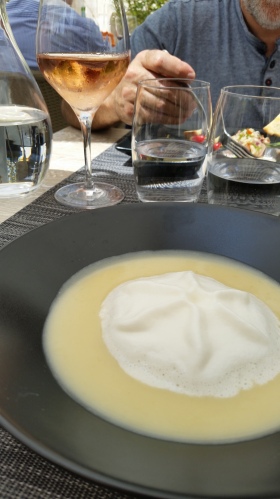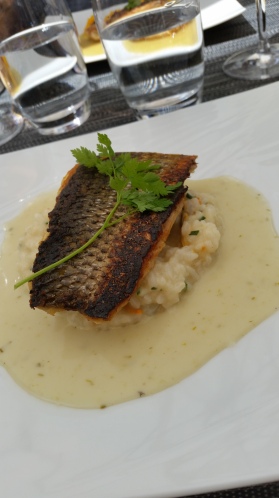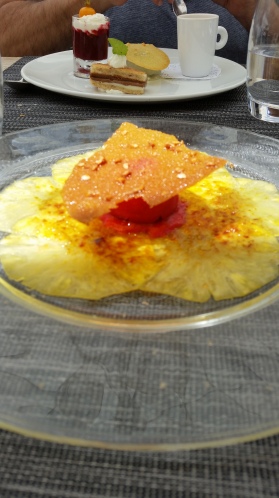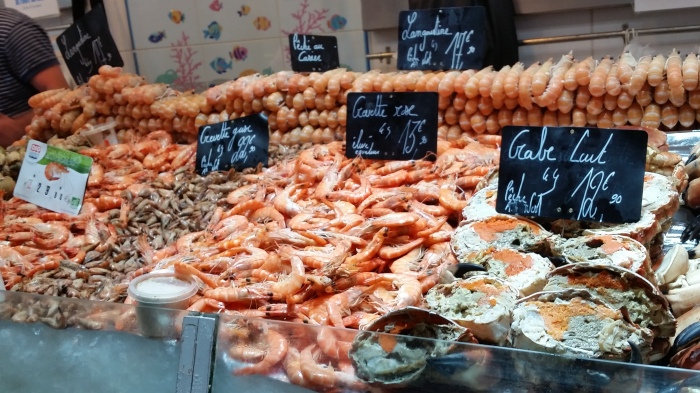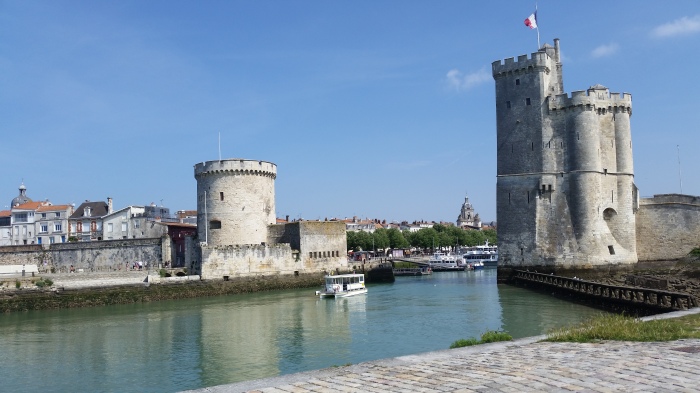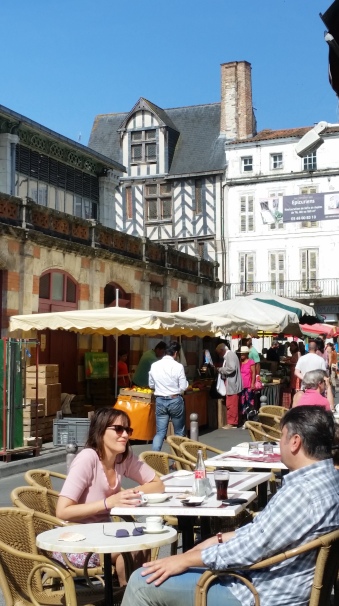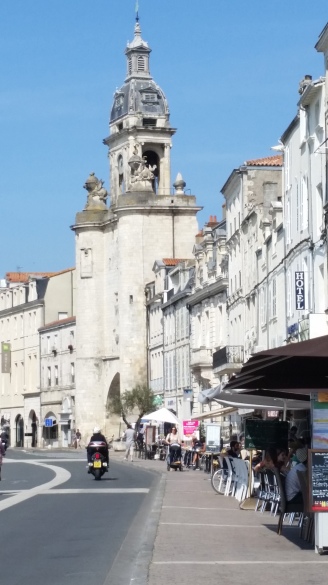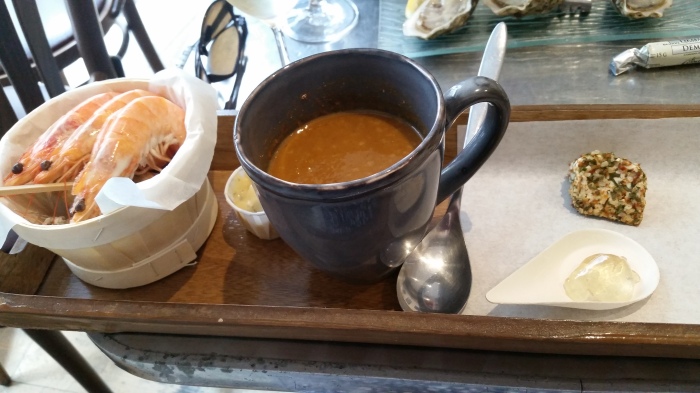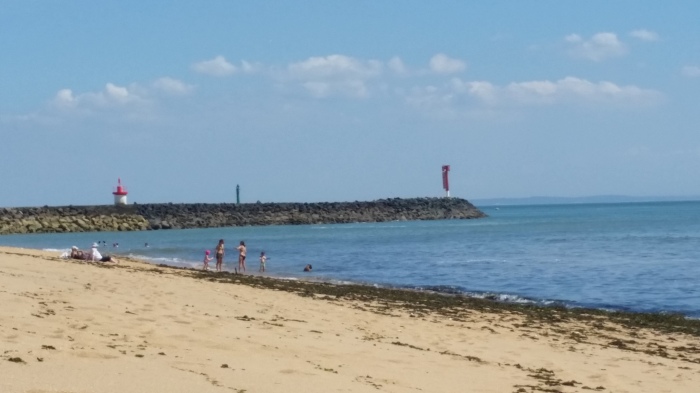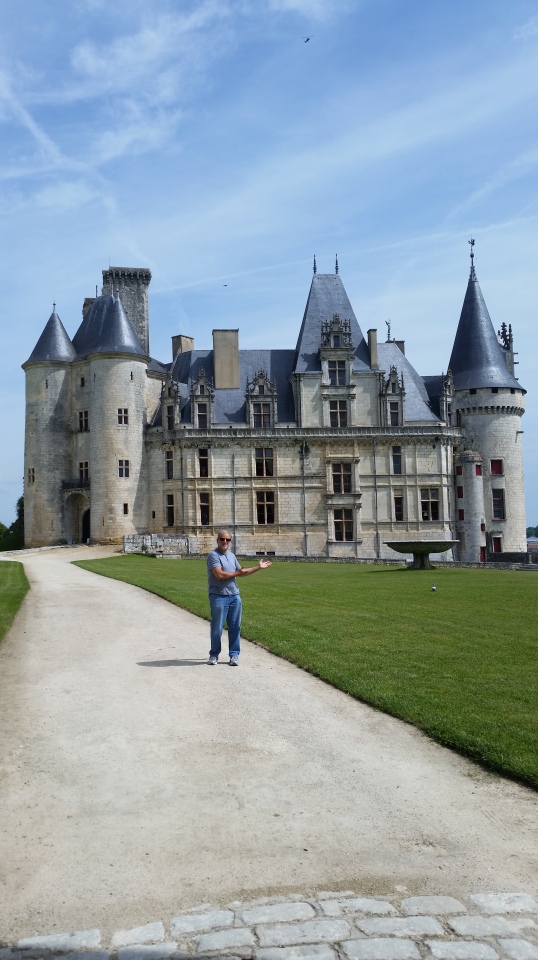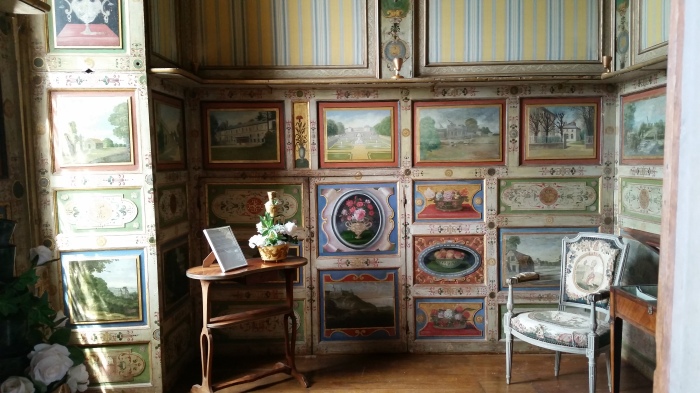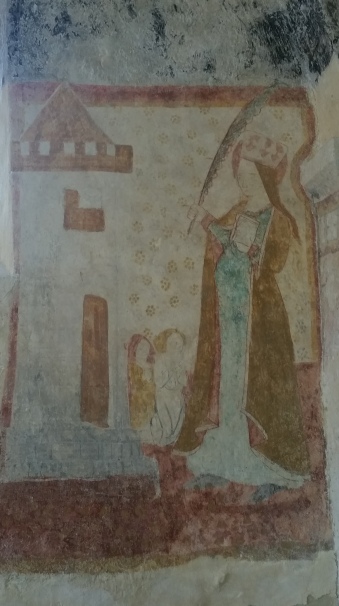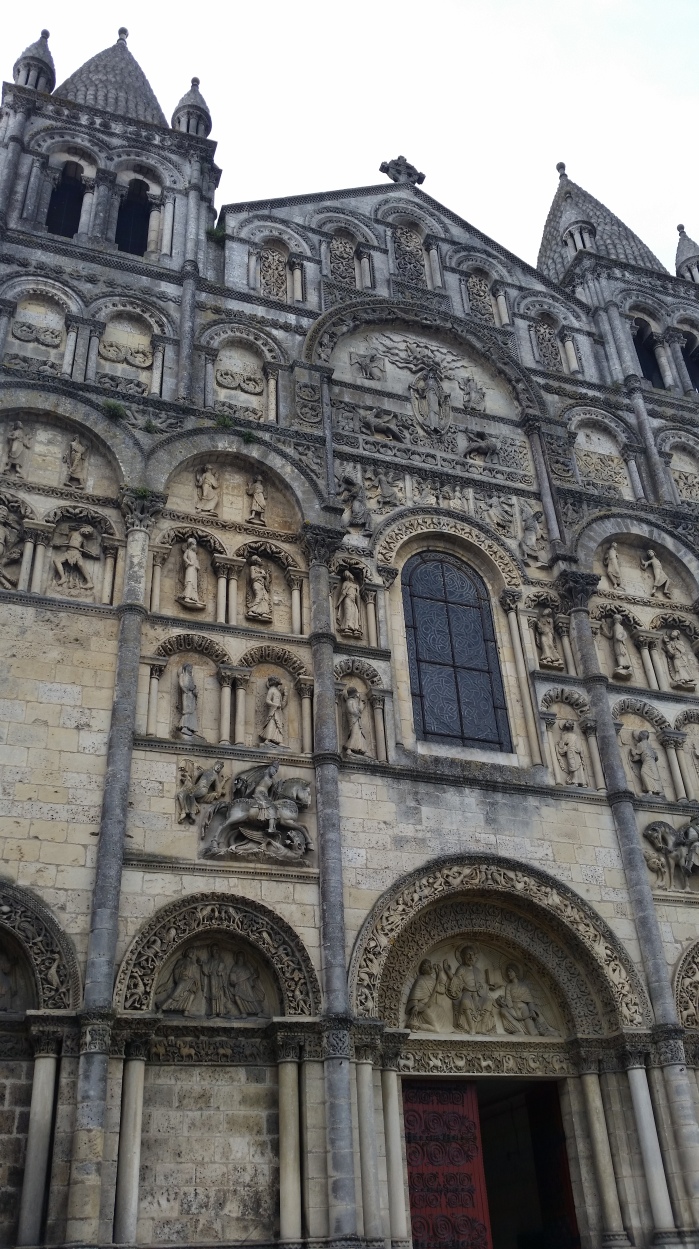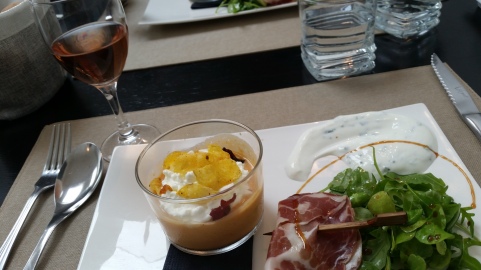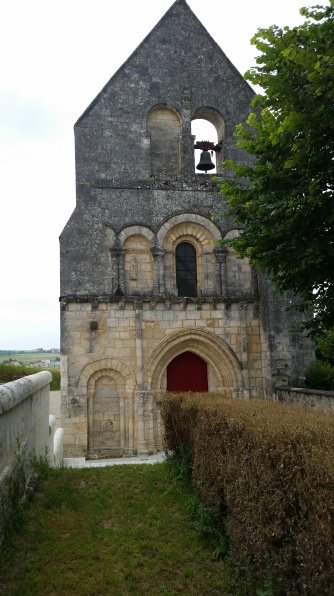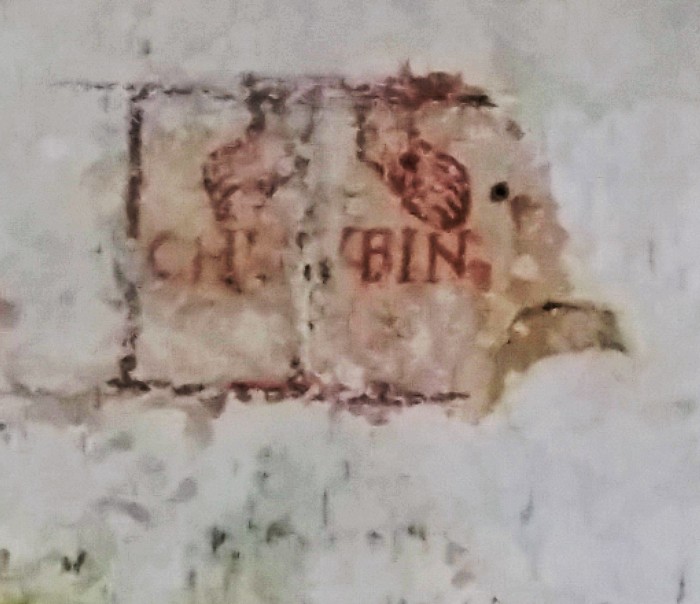Amy
100+ Posts
Taken from my Blog entries. Even more photos there:
https://argilman.wordpress.com/
After spending a week in Paris, we planned to pick up a car and drive southwest to the Charente. “Where?” everyone is saying. I’d never heard of it either. Over the past few years we’ve become somewhat obsessed with finding the little Romanesque churches in Europe. As I was researching, I learned that a very high concentration of these buildings is in the Charente. It’s an area that seems popular with French and Brits largely looking for seaside vacations, with a long coast on the Atlantic and the interesting town La Rochelle. It’s also Cognac territory inland, has a lot of natural areas of rivers and marshland, and is a bit more than an hour’s drive to the Bordeaux wine region. Why not?
I booked an appealing looking gite a 10 minute drive from Cognac that looks amazingly comfortable and has fantastic reviews. I put together a detailed Google map–we’ll likely only hit 10% of what’s on it, I suspect there will be afternoons of lazing around the pool watching the grapes grow while drinking Pineau de Charente and eating chevre and cherries. Le Cerisier
Google Map
Tuesday
Tuesday we packed up in Paris, and went over to Montparnasse to catch our train to Angeloume. The train strike had been called to begin that evening, which I suspect contributed to the crowds at the station, with people changing their plans to avoid the possibility of cancelled or delayed trains. As we were in the vicinity of Orleans, Larry was following along with Google Maps, and noticed huge delays on the highway. We later learned that floodwaters had led to highway closures, with many drivers diverted or stuck. The train sounded better and better.
In Angeloume we picked up our little rental car at the station, and drove the 40 minutes to our gite in Segonzac, in the midst of the Cognac area. Segonzac is a small town, but does have two boulangeries/patisseries, 2 restaurants, and a grocery store. Our gite is a five minute drive from town, along a curving stretch of road bisecting vineyards. It’s charming and perfect for two people, with the owners cats stopping by. We settled in, got a few things from the grocery, and had cheese and bread for dinner.
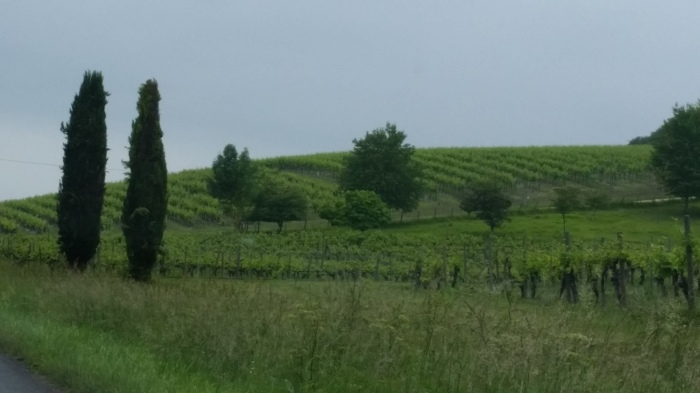
Wednesday
Wednesday we first drove the short distance into Jonac to go to the covered market, which turned out to be barely open, just two vendors. So 15 minutes later we were in Cognac, where the market was livelier (though still with many closed vendor areas, I was told Tuesday, Friday and Saturday are the big market days). Bought produce, a local chevre, and some good looking sausages. We walked around Cognac for a bit. There’s a pedestrian shopping district, a few small museums, and several large cognac distillers to visit. On a grey, cold June it was slow moving, I suspect things are busier in the summer.
For lunch, we went to a place the gite owners had recommended for an inexpensive nearby set lunch. In the pretty village of Criteuil La Magdeline, A Delices du Terroir was full with a biking group, but the smiling owner set us up on the patio. The food was homestyle cooking, nothing earth shattering, but at 12 euros for a three-course meal including wine and coffee, eaten on a patio under a 11th century church belltower, who argues?
We drove around a bit exploring. One of the loveliest villages we encountered was Ligniere-Sonnwville, set alongside a stream, with 17th century chateau now turned into the town hall, a 11th century church with a carving on the tryptich shows the Three Kings, the old washhouses for processing the linen that was grown and woven in town, a sunken garden, and a little linen museum, sadly closed.
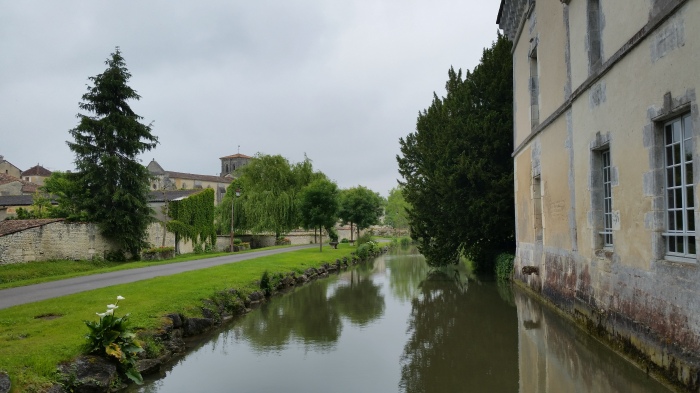
We poked around a few of the other villages, finding more Romanesque churches among the vineyards, fields of poppies, and then…a Neolithic dolmen, sitting among the vines in Saint-Fort-sur-le-Ne. The stones have been dated to 3000 BC, and the top stone weighs 400 tons.
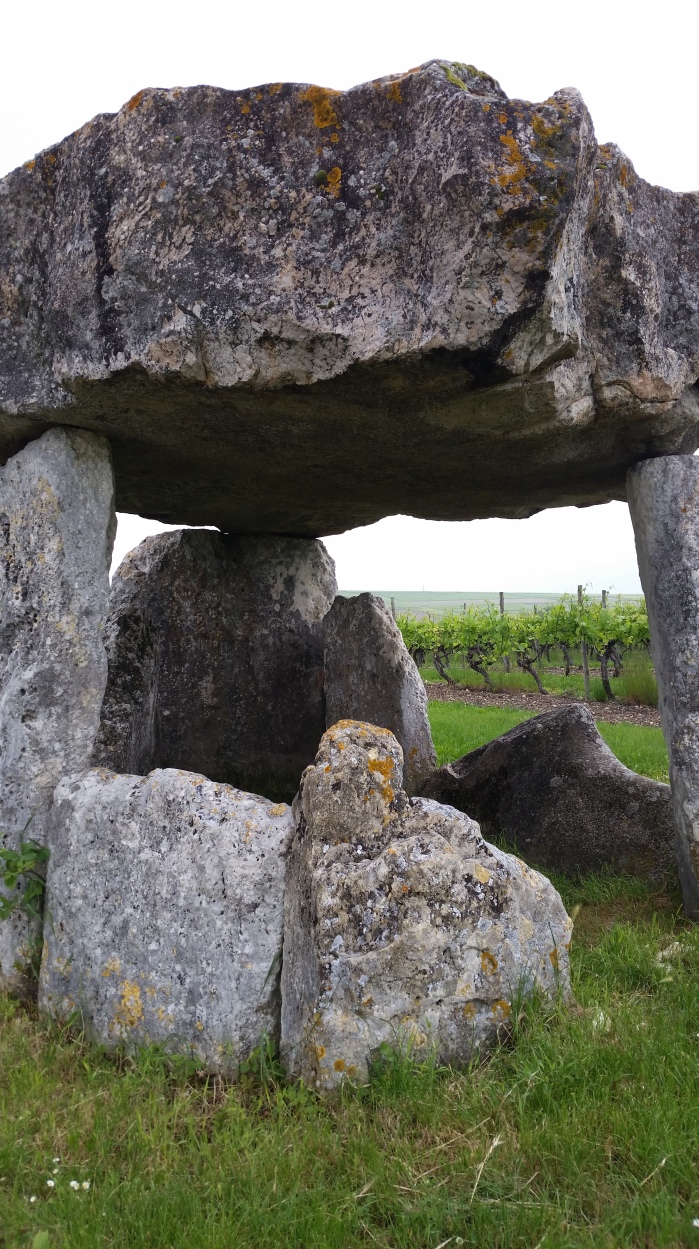
Back at the gite I cooked lentils with sausages (no photo, since lentils and sausages taste wonderful but are hardly pretty), we enjoyed dessert from the patisserie, and slept comfortably. One of these days the sun will come out again!
Thursday
Thursday morning we drove the 45 minutes west to Saintes. This is a large riverfront town with several fascinating things to see, and a charming old core.
We first grabbed a parking space right at the Roman Amphitheater. Built in the 1st century under Claudius, it could hold 15-18,000 people. And was used for all those good traditional Roman entertainments. It was built into a natural bowl, so the seating was built into the sides. Originally there were short walls above, which have since tumbled. And speaking of ongoing maintenance, we saw a crew carefully tearing ivy off the exterior walls. There were very few people there, just a few school groups. There’s an audioguide (they even have English) with a lot of detail before it goes into a cheesy reenactment of a gladiator fight. You can walk a trail from here to the rest of town, although we were told its a long, hilly walk.
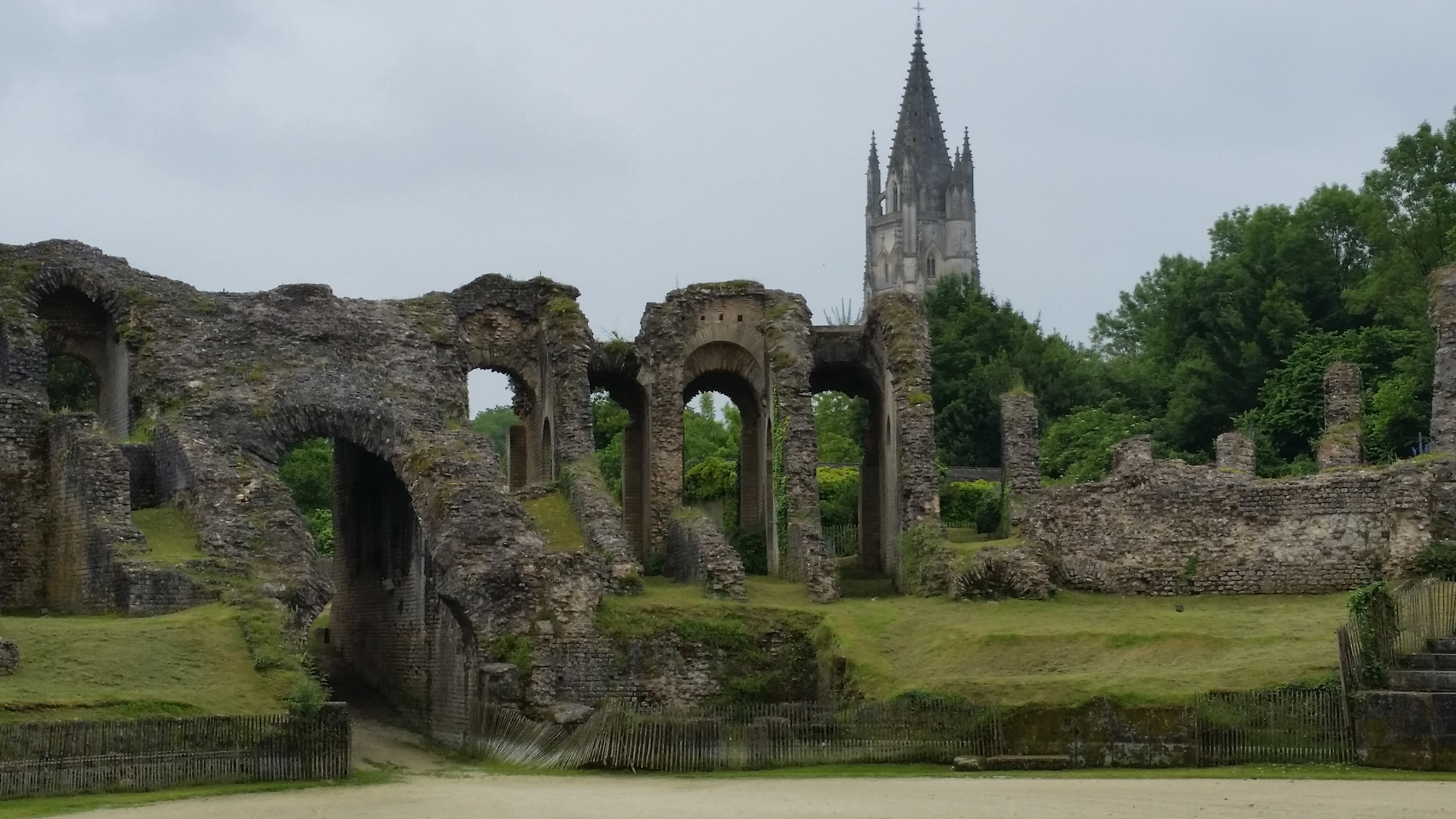
We headed over to see one of the churches we were interested in, Saint-Eutrope basilica. Originally a church in the 6th century, the oldest part now is from the 11th century. There are two parts,the upper church with the addition of its Gothic tower, and an older lower crypt. For those interested, the head of Siaint Eutrope is inside. We were more interested in the Romanesque carvings, both in the upper church and the splendidly creepy crypt. Acanthus flowers, intertwined vines, animals, humans, lots of details are well preserved in spite of the wars of religion and the Revolution. Many moneys hide in the crypt, a popular image in Romanesque art as they can symbolize the Devil and also humans in a state of degeneracy. And my favorite mermaid/siren who we’ve seen many times before.
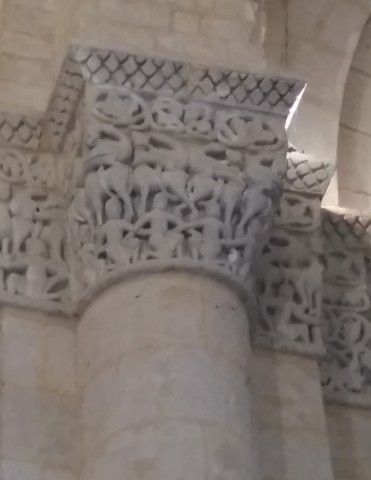
After spending time in ST Eutrope, we headed over the river to the other part of town. We ran into the same couple we had met in the Amiptheater and the church, they’re from Portugal and their English certainly better than our Portuguese, which consists of thank you and hello. Lunch was at La Table du Marion, where a smiling wife runs the small dining room while her husband is the chef. We had the daily menu for 22 euros, starting with a good slice of homemade pate, then a wonderful beef daube, and ending with cherry clafouti for Larry and creme caramel for me. We saw others eating fabulous-smelling fish, and one lucky couple having a lengthy tasting menu. Good meal, and nice people.
We also saw the 1st century Arch of Germanicus, and a flamboyant gothic church, Saint Pierre, with fabulous tympanium and flying buttresses.
Larry had noted that we were close to the oyster-farming area near the coast, so we drove another 1/2 hour west to Mornac-sur-Sedre. This area is more water than land, hundreds of inlets and pools devoted to oyster cultivation. Mornac was unfortunetely largely a tourist town, with streets of boutiques selling tsotkes to the few tourists wandering around. Still some pretty scenes to enjoy. But we did go out on a road along the oyster beds to see the shacks and boats.
Back home, we enjoyed our little bottle of Pineau des Charentes, the local apero made from grape must and cognac (that has a slow kick, we were told of village fetes where everyone was falling over after an afternoon of drinking this) , then made a nice vegetarian dinner of steamed artichoke, salad and endive gratin. Wish I could get this quality for these reasonable prices at home!
Friday
One of our favorite things to do in the countryside in Italy and France is to just drive around, and turn off whenever we see one of the little signs pointing the way to something of historical interest–old church, castle, forest, whatever. Today we started off by driving to a nearby town where we’d heard there was a small market of local producers. It turned out to be one old guy in his truck selling jam, but behind the parking lot was a large farmstand, with local people lining up to buy crates of tiny melons, white asparagus, and enormous heads of lettuce. (Later, we asked our gite owner what people were doing with a crate of melons, and she told us they fill them with Pineau de Charente as an aperitif. Drink your fruit, win-win.) White asparagus, artichokes, and a bottle of the local plonk went in the car with us.
Near the village of Bassac, we saw one of the historical marker signs, and found the Abbey of Bassac, founded in the 11nth century. The buildings were added to over the centruries, the Abbey was sold during the Revolution, and was used as various points as a hospital and most recently as a school. Not much to be seen of the original except part of the cloister; though the 15th century extension has a grand balcony and staircase, leading to a wild garden along the banks of the river.From the riverfront you can see an old lavoire, wash house, and old bridge. And abandoned in front, a 12th century lanterne du mort, used in medieval cemeteries.
Another village, another Romanesque church. We found this little one down the road in Graves Saint-Amant. Much of the external decoration was gone, except for a few capitals and this wonderful line of heads.
We also stopped at the site of an archaeological dig,where according to the signposts they’ve found dinosaur remains. This part of the Charente is crisscrossed by many little rivers, we seemed to be rolling over tiny single-lane bridges every kilometer or so. Oh, another dolmen, this time partially collapsed and sitting in someone’s flax field. We’ve also learned to slow down when we see an elaborate gate–there’s usually a chateau or grand old house behind.
Lunchtime! Our gite owners has recommended L’Islle in the town of Bassac. In this tiny, towhere town, the place was hopping with local buisness people. There’s a beautiful garden, though they weren’t seating out there today because of the damp. For 18 euros, you can choose a daily 3-course set men. It was amazing, especially for that price. We started with a bowl of fresh seafood, in two different sauces. Then salmon with fennel puree and potatoes in a fennel-carrot sauce, the finally a molleaux, tiny warm chocolate cake.We’ll be back.
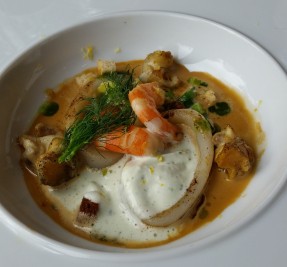
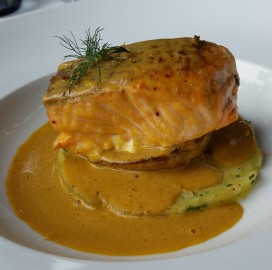
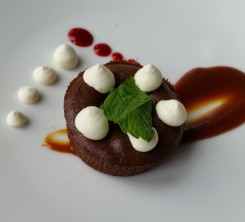
Another village, with another church with some fine old capitals and gated wall outside.
Back home, we went down the road to visit neighbor Monsieur Raby, who with his daughter own one of the many cognac vineyards and distilleries. We got a nice little tour, with explanation of the process. He sells much of his production to the large cognac makers, but keeps some to age and bottle himself. He also makes Pineau de Charente and wines, and his daughter speaks English, having some some of her wine training in the US.
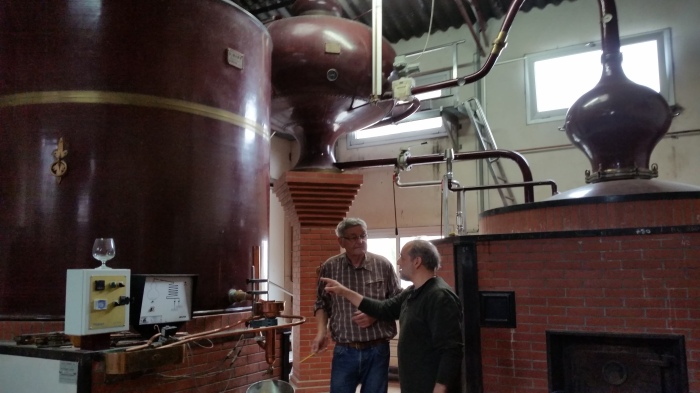
Larry, not a cognac drinker, conceded that the top of the line aged stuff might be OK. A few bottles went home with us.The aroma here was so strong, you could almost taste the cognac. The amount lost to evaporation is called “the Angel’s Share.”His father made several barrels of cognac in 1970, it is still aging.
Continued in Part 2
https://argilman.wordpress.com/
After spending a week in Paris, we planned to pick up a car and drive southwest to the Charente. “Where?” everyone is saying. I’d never heard of it either. Over the past few years we’ve become somewhat obsessed with finding the little Romanesque churches in Europe. As I was researching, I learned that a very high concentration of these buildings is in the Charente. It’s an area that seems popular with French and Brits largely looking for seaside vacations, with a long coast on the Atlantic and the interesting town La Rochelle. It’s also Cognac territory inland, has a lot of natural areas of rivers and marshland, and is a bit more than an hour’s drive to the Bordeaux wine region. Why not?
I booked an appealing looking gite a 10 minute drive from Cognac that looks amazingly comfortable and has fantastic reviews. I put together a detailed Google map–we’ll likely only hit 10% of what’s on it, I suspect there will be afternoons of lazing around the pool watching the grapes grow while drinking Pineau de Charente and eating chevre and cherries. Le Cerisier
Google Map
Tuesday
Tuesday we packed up in Paris, and went over to Montparnasse to catch our train to Angeloume. The train strike had been called to begin that evening, which I suspect contributed to the crowds at the station, with people changing their plans to avoid the possibility of cancelled or delayed trains. As we were in the vicinity of Orleans, Larry was following along with Google Maps, and noticed huge delays on the highway. We later learned that floodwaters had led to highway closures, with many drivers diverted or stuck. The train sounded better and better.
In Angeloume we picked up our little rental car at the station, and drove the 40 minutes to our gite in Segonzac, in the midst of the Cognac area. Segonzac is a small town, but does have two boulangeries/patisseries, 2 restaurants, and a grocery store. Our gite is a five minute drive from town, along a curving stretch of road bisecting vineyards. It’s charming and perfect for two people, with the owners cats stopping by. We settled in, got a few things from the grocery, and had cheese and bread for dinner.

Wednesday
Wednesday we first drove the short distance into Jonac to go to the covered market, which turned out to be barely open, just two vendors. So 15 minutes later we were in Cognac, where the market was livelier (though still with many closed vendor areas, I was told Tuesday, Friday and Saturday are the big market days). Bought produce, a local chevre, and some good looking sausages. We walked around Cognac for a bit. There’s a pedestrian shopping district, a few small museums, and several large cognac distillers to visit. On a grey, cold June it was slow moving, I suspect things are busier in the summer.
For lunch, we went to a place the gite owners had recommended for an inexpensive nearby set lunch. In the pretty village of Criteuil La Magdeline, A Delices du Terroir was full with a biking group, but the smiling owner set us up on the patio. The food was homestyle cooking, nothing earth shattering, but at 12 euros for a three-course meal including wine and coffee, eaten on a patio under a 11th century church belltower, who argues?
We drove around a bit exploring. One of the loveliest villages we encountered was Ligniere-Sonnwville, set alongside a stream, with 17th century chateau now turned into the town hall, a 11th century church with a carving on the tryptich shows the Three Kings, the old washhouses for processing the linen that was grown and woven in town, a sunken garden, and a little linen museum, sadly closed.

We poked around a few of the other villages, finding more Romanesque churches among the vineyards, fields of poppies, and then…a Neolithic dolmen, sitting among the vines in Saint-Fort-sur-le-Ne. The stones have been dated to 3000 BC, and the top stone weighs 400 tons.

Back at the gite I cooked lentils with sausages (no photo, since lentils and sausages taste wonderful but are hardly pretty), we enjoyed dessert from the patisserie, and slept comfortably. One of these days the sun will come out again!
Thursday
Thursday morning we drove the 45 minutes west to Saintes. This is a large riverfront town with several fascinating things to see, and a charming old core.
We first grabbed a parking space right at the Roman Amphitheater. Built in the 1st century under Claudius, it could hold 15-18,000 people. And was used for all those good traditional Roman entertainments. It was built into a natural bowl, so the seating was built into the sides. Originally there were short walls above, which have since tumbled. And speaking of ongoing maintenance, we saw a crew carefully tearing ivy off the exterior walls. There were very few people there, just a few school groups. There’s an audioguide (they even have English) with a lot of detail before it goes into a cheesy reenactment of a gladiator fight. You can walk a trail from here to the rest of town, although we were told its a long, hilly walk.

We headed over to see one of the churches we were interested in, Saint-Eutrope basilica. Originally a church in the 6th century, the oldest part now is from the 11th century. There are two parts,the upper church with the addition of its Gothic tower, and an older lower crypt. For those interested, the head of Siaint Eutrope is inside. We were more interested in the Romanesque carvings, both in the upper church and the splendidly creepy crypt. Acanthus flowers, intertwined vines, animals, humans, lots of details are well preserved in spite of the wars of religion and the Revolution. Many moneys hide in the crypt, a popular image in Romanesque art as they can symbolize the Devil and also humans in a state of degeneracy. And my favorite mermaid/siren who we’ve seen many times before.

After spending time in ST Eutrope, we headed over the river to the other part of town. We ran into the same couple we had met in the Amiptheater and the church, they’re from Portugal and their English certainly better than our Portuguese, which consists of thank you and hello. Lunch was at La Table du Marion, where a smiling wife runs the small dining room while her husband is the chef. We had the daily menu for 22 euros, starting with a good slice of homemade pate, then a wonderful beef daube, and ending with cherry clafouti for Larry and creme caramel for me. We saw others eating fabulous-smelling fish, and one lucky couple having a lengthy tasting menu. Good meal, and nice people.
We also saw the 1st century Arch of Germanicus, and a flamboyant gothic church, Saint Pierre, with fabulous tympanium and flying buttresses.
Larry had noted that we were close to the oyster-farming area near the coast, so we drove another 1/2 hour west to Mornac-sur-Sedre. This area is more water than land, hundreds of inlets and pools devoted to oyster cultivation. Mornac was unfortunetely largely a tourist town, with streets of boutiques selling tsotkes to the few tourists wandering around. Still some pretty scenes to enjoy. But we did go out on a road along the oyster beds to see the shacks and boats.
Back home, we enjoyed our little bottle of Pineau des Charentes, the local apero made from grape must and cognac (that has a slow kick, we were told of village fetes where everyone was falling over after an afternoon of drinking this) , then made a nice vegetarian dinner of steamed artichoke, salad and endive gratin. Wish I could get this quality for these reasonable prices at home!
Friday
One of our favorite things to do in the countryside in Italy and France is to just drive around, and turn off whenever we see one of the little signs pointing the way to something of historical interest–old church, castle, forest, whatever. Today we started off by driving to a nearby town where we’d heard there was a small market of local producers. It turned out to be one old guy in his truck selling jam, but behind the parking lot was a large farmstand, with local people lining up to buy crates of tiny melons, white asparagus, and enormous heads of lettuce. (Later, we asked our gite owner what people were doing with a crate of melons, and she told us they fill them with Pineau de Charente as an aperitif. Drink your fruit, win-win.) White asparagus, artichokes, and a bottle of the local plonk went in the car with us.
Near the village of Bassac, we saw one of the historical marker signs, and found the Abbey of Bassac, founded in the 11nth century. The buildings were added to over the centruries, the Abbey was sold during the Revolution, and was used as various points as a hospital and most recently as a school. Not much to be seen of the original except part of the cloister; though the 15th century extension has a grand balcony and staircase, leading to a wild garden along the banks of the river.From the riverfront you can see an old lavoire, wash house, and old bridge. And abandoned in front, a 12th century lanterne du mort, used in medieval cemeteries.
Another village, another Romanesque church. We found this little one down the road in Graves Saint-Amant. Much of the external decoration was gone, except for a few capitals and this wonderful line of heads.
We also stopped at the site of an archaeological dig,where according to the signposts they’ve found dinosaur remains. This part of the Charente is crisscrossed by many little rivers, we seemed to be rolling over tiny single-lane bridges every kilometer or so. Oh, another dolmen, this time partially collapsed and sitting in someone’s flax field. We’ve also learned to slow down when we see an elaborate gate–there’s usually a chateau or grand old house behind.
Lunchtime! Our gite owners has recommended L’Islle in the town of Bassac. In this tiny, towhere town, the place was hopping with local buisness people. There’s a beautiful garden, though they weren’t seating out there today because of the damp. For 18 euros, you can choose a daily 3-course set men. It was amazing, especially for that price. We started with a bowl of fresh seafood, in two different sauces. Then salmon with fennel puree and potatoes in a fennel-carrot sauce, the finally a molleaux, tiny warm chocolate cake.We’ll be back.



Another village, with another church with some fine old capitals and gated wall outside.
Back home, we went down the road to visit neighbor Monsieur Raby, who with his daughter own one of the many cognac vineyards and distilleries. We got a nice little tour, with explanation of the process. He sells much of his production to the large cognac makers, but keeps some to age and bottle himself. He also makes Pineau de Charente and wines, and his daughter speaks English, having some some of her wine training in the US.

Larry, not a cognac drinker, conceded that the top of the line aged stuff might be OK. A few bottles went home with us.The aroma here was so strong, you could almost taste the cognac. The amount lost to evaporation is called “the Angel’s Share.”His father made several barrels of cognac in 1970, it is still aging.
Continued in Part 2
Last edited:

